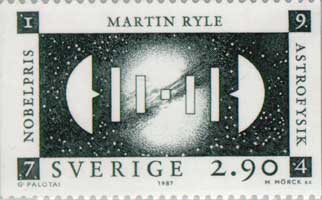.
Martin Ryle

Sir Martin Ryle (September 27, 1918 October 14, 1984 ) was a British radio astronomer who developed revolutionary radio telescope systems (see e.g. aperture synthesis) and used them for accurate location and imaging of weak radio sources. In 1946 Ryle and Vonberg were the first people to publish interferometric astronomical measurements at radio wavelengths, although it is claimed that Joseph Pawsey from the University of Sydney had actually made interferometric measurements earlier in the same year. With improved equipment, Ryle observed the most distant known galaxies in the universe at that time. He was the first Professor of Radio Astronomy at the University of Cambridge, and founding director of the Mullard Radio Astronomy Observatory. He was Astronomer Royal from 1972 to 1982.
Ryle and Antony Hewish shared the Nobel Prize for Physics in 1974, the first Nobel prize awarded in recognition of astronomical research.
Short biography
After earning a physics degree at the University of Oxford in 1939, Ryle worked with the Telecommunications Research Establishment on the design of radar equipment during World War II. After the war he received a fellowship at the Cavendish Laboratory. The focus of early work in Cambridge was on radio waves from the Sun. Ryle's interest quickly shifted to other areas, however, and to explore those he decided early on that the Cambridge group should develop new observing techniques. As a result, Ryle was the driving force in the creation and improvement of interferometry and aperture synthesis, which have contributed immensely to upgrading the quality of radio astronomical data. In 1946 he built the first multi-element astronomical radio interferometer.

He guided the Cambridge radio astronomy group in the production of several important radio source catalogues. For example, the Third Cambridge (3C) Catalogue 1959 helped lead to the discovery of the first quasi-stellar object (quasar). While serving as university lecturer in physics at Cambridge from 1948 to 1959, Ryle became director of the Mullard Radio Astronomy Observatory 1957, and professor of radio astronomy in 1959. He was elected a fellow of the Royal Society in 1952, was knighted in 1966, and succeeded Sir Richard Woolley as Astronomer Royal (1972-82). Ryle and Antony Hewish shared the Nobel Prize for Physics in 1974, the first Nobel prize awarded in recognition of astronomical research. Sir Martin Ryle died October 14, 1984, in Cambridge. Martin Ryle was undoubtably one of the great astronomers of the 20th Century. He was sometimes considered difficult to work with - in fact he often worked in an office at the Mullard Radio Astronomy Observatory to avoid disturbances from other members of the Cavendish Laboratory and to avoid getting into heated arguments, as Ryle had a hot temper. Ryle worried that Cambridge would lose its standing in the radio astronomy community as other radio astronomy groups had much better funding, so he encouraged a certain amount of secrecy about his aperture synthesis methods in order to keep an advantage for the Cambridge group. Ryle had a famous heated argument with Fred Hoyle of the Institute of Astronomy about Hoyle's Steady State Universe (see also the note on the 2C source survey), which somewhat restricted collaboration between the Cavendish Radio Astronomy Group and the Institute of Astronomy during the 1960s.
Honours
Awards
- Hughes Medal (1954)
- Gold Medal of the Royal Astronomical Society (1964)
- Henry Draper Medal (1965)
- Royal Medal (1973)
- Bruce Medal (1974)
- Nobel Prize for Physics (1974)
Named after him
- Ryle Telescope at Mullard Radio Astronomy Observatory
Links
Obituaries
References
- M. Ryle, D. Vonberg, Solar radiation on 175Mc/s, Nature 158 pp 339 (September 1946) - Observations from the first multi-element astronomical radio interferometer
Astronomer Royal 1972 - 1982
Preceded by: Richard van der Riet Woolley
Succeeded by: Arnold Wolfendale
Retrieved from "http://en.wikipedia.org/"
All text is available under the terms of the GNU Free Documentation License

